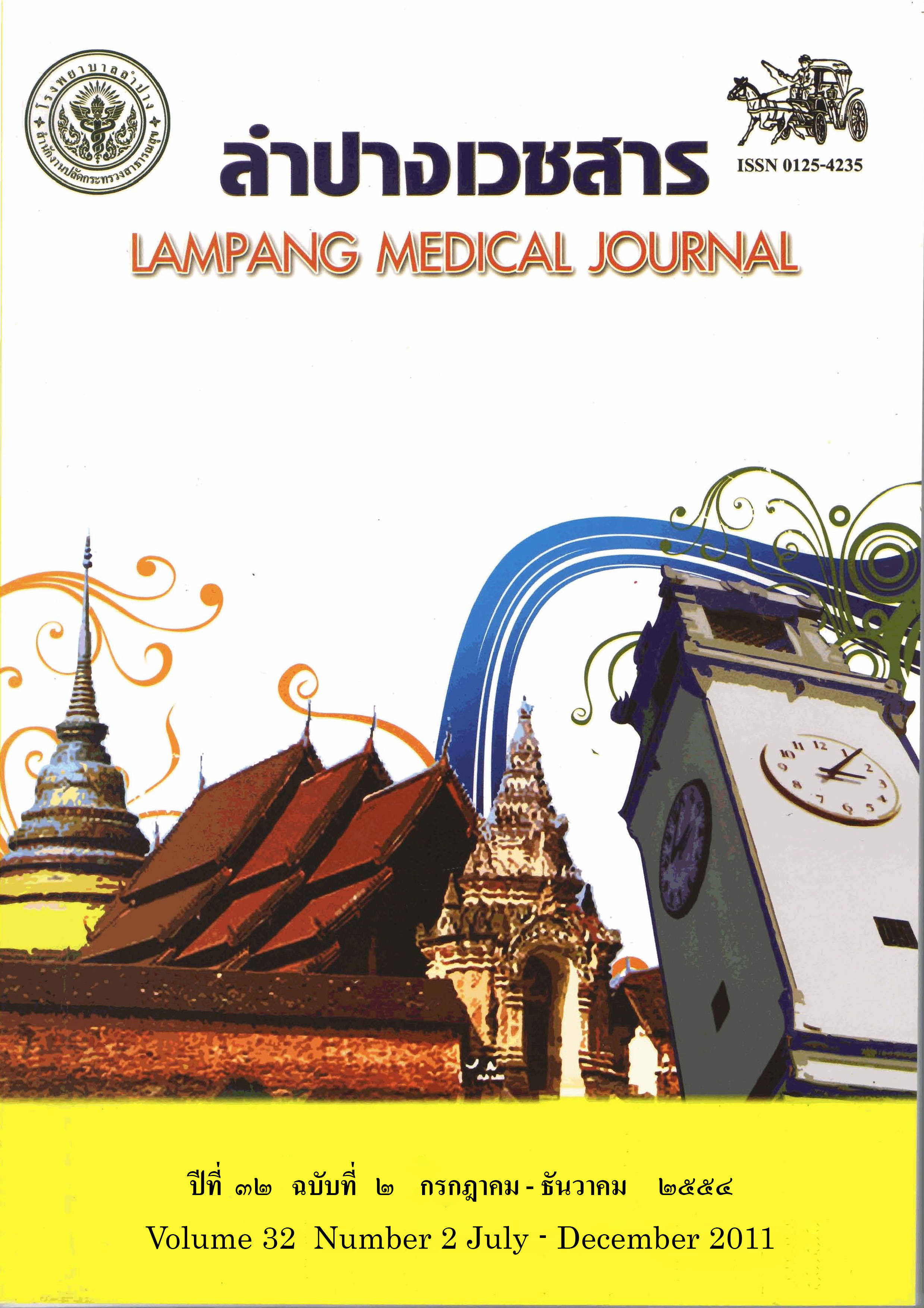Efficacy of Invented Ice Chamber for Storage and Transport of Specimen for Blood Gas Analysis
Main Article Content
Abstract
Background : Arterial blood samples are commonly collected in syringes and stored in ice slurry before blood gas analysis. The specimens may be contaminated by water leakage into the syringes. The author has invented a ready-to-used ice chamber from a plastic cup and 20-ml disposable syringe to store and transport them.
Objective : To study the use efficacy and blood gas analysis results of specimens collected in plastic syringes stored in the invented ice chamber comparing with the conventional crushediced container.
Material and method : A laboratory experimental study was conducted on arterial blood samples of 25 anesthetic patients sending for blood gas analysis during the surgery in Lampang Hospital. Specimens of each patient were collected in two plastic syringes and randomly allocated into 2 groups. They study group was stored and transported in the invented ice chamber whereas the control group was in the crushed-iced container. Sample storage time and incidence of specimen contamination were recorded. Difference of core temperature at 5, 10, 15, 30 minutes and results of blood gas analysis between the groups were analyzed with paired
t–test.
Results : Core temperature in the ice chamber was higher than the crush-iced container at 5 minutes (0.28 ± 0.15 vs 0.09 ± 0.05 ºC) and 10 minutes (0.11 ± 0.08 vs 0.03 ± 0.03 ºC) significantly (p<0.001), but was not different at 15 and 30 minutes (p = 0.283 and 0.076
respectively). Sample storage time was 4.62 ± 1.40 minutes and specimen contamination was not found. The average pH, PO2, PCO2, HCO3 and base excess of both groups were not significantly different.
Conclusion : Efficacy to storage and transport specimens for blood gas analysis of the invented ice chamber was not different from the conventional crushed-iced container.
Article Details

This work is licensed under a Creative Commons Attribution-NonCommercial-NoDerivatives 4.0 International License.
บทความที่ส่งมาลงพิมพ์ต้องไม่เคยพิมพ์หรือกำลังได้รับการพิจารณาตีพิมพ์ในวารสารอื่น เนื้อหาในบทความต้องเป็นผลงานของผู้นิพนธ์เอง ไม่ได้ลอกเลียนหรือตัดทอนจากบทความอื่น โดยไม่ได้รับอนุญาตหรือไม่ได้อ้างอิงอย่างเหมาะสม การแก้ไขหรือให้ข้อมูลเพิ่มเติมแก่กองบรรณาธิการ จะต้องเสร็จสิ้นเป็นที่เรียบร้อยก่อนจะได้รับพิจารณาตีพิมพ์ และบทความที่ตีพิมพ์แล้วเป็นสมบัติ ของลำปางเวชสาร
References
Wiwanitkit V. Quality control in blood gas analysis. Yasothon Med J 1999; 2:160-6.
Ancic P, Munoz F. Importance of pre-analytical variables in the quality of arterial blood gas determination. Rev Med Chil 1997; 125:1045–8.
Wiwanitkit V. Glass syringe are better than plastic for preserving arterial blood gas for oxygen partial pressure determination: an explanation based on nanometerial composition. Int J Nanomedicine 2006; 1(2):223-4.
Smeenk FW, Janssen JD, Adrends BJ, Harff GA, van den Bosch JA, Schonberger JP, et al. Effects of four different methods of sampling arterial blood and storage time on gas tensions and shunt calculation in 100 % oxygen test. Eur Respir J 1997; 10(4):910-3.
Biswas CK, Ramos JM, Agroyannis B, Kerr DN. Blood gas analysis: effect of air bubbles in syringe and delay in estimation. Br Med J 1982; 284(6320):923-7.
Knowles TP, Mullin RA, Hunter JA, Douce FH. Effects of syringe material, sample storage time, and temperature on blood gases and oxygen saturation in arterialized human blood samples. Respir Care 2006; 51(7):732-6.
พงษ์ธารา วิจิตรเวชไพศาล. การวิเคราะห์ก๊าซในเลือด. พิมพ์ครั้งที่ 3. กรุงเทพฯ: พี.เอ.ลีฟวิ่ง; 2545.
วิโรจน์ ไววานิชกิจ. การตรวจวิเคราะห์ก๊าซในเลือด. พิมพ์ครั้งที่ 1. กรุงเทพฯ: สำนักพิมพ์แห่งจุฬาลงกรณ์มหาวิทยาลัย; 2551.
Beaulieu M, Lapointe Y, Vinet B. Stability of PO2, PCO2, and pH in fresh blood samples stored in a plastic syringe with low heparin in relation to various blood-gas and hematological parameters. Clin Biochem 1999; 32(2):101-7.
American Association for Respiratory Care. AARC Clinical Practice Guideline: blood gas analysis and hemoximetry: 2001 revision and update. Respir Care 2001; 46(5):498–505.


